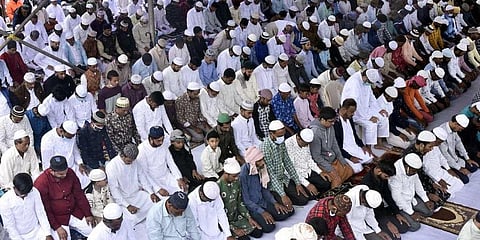

Pan-Islamism is a political ideology advocating the unity of Muslims under one Islamic country or state—often a caliphate—or an international organisation with Islamic principles. The ummah (Muslim community) is the focus of allegiance and mobilisation, excluding ethnicity, nationality and race as primary unifying factors. Pan-Islamism emerged during the late 19th century as a global movement for Islamic reform and struggle against European imperialism. The major leaders of the Pan-Islamist movement were the triad of Jamal al-Din Afghani (1839–1897), Muhammad Abduh (1849–1905) and Sayyid Rashid Rida (1865–1935). Pan-Islamism gained momentum in India during the Khilafat Movement during the 1918–1924 period.
A global Caliphate, real or imaginary, is the moving force behind the idea of Pan-Islamism. Dismemberment of the Ottoman Empire following World War I triggered confusion and dismay in the Muslim world. Naeem Qureshi in his Pan-Islam in British India: The Politics of the Khilafat Movement 1918–1924 observes that in British India, Turkey had given the Muslim community a feeling of security in the midst of the Hindu majority.
The Indian Muslims were anxious about an alien empire. Muslims were divided on regional, sectoral, class and caste lines. These divisions prevented the emergence of a homogeneous monolithic community. But bonds of common religion and a sense of shared history helped the Muslim community in India and across the world overcome these divisions. “What made pan-Islam more intelligible to Indian Muslims was the growing consciousness among them that they were the members of a world-wide ecumenical community, stretching from the shores of the Atlantic to the Straits of Malacca in one unbroken chain,’’ observes Qureshi.
Pan-Islamists have always been committed to the institution and preservation of the caliphate, this being the centre of the Islamic faith. According to them, it is incumbent upon the entire ummah to rally around the caliphate. Pan-Islamism in India unfolded through the Khilafat Movement during 1918–24 and culminated in the emergence of Muslim nationalism and the Pakistan movement.
The Hijrat Movement of 1920 was another facet of pan-Islamism that gave preference to religious affiliation over national allegiance. Thousands of Indian Muslims, under severe emotional stress, began to emigrate from India to Afghanistan that was under Islamic rule. This was an imitation of the Prophet Muhammed’s Hijrat to Madinah in 622 CE. The Ali Brothers and Zafar Ali Khan, prominent Khilafatists, put forth Hijrat as an alternative to jihad. The Hijrat Movement was a colossal failure.
Pan-Islamism, Islamism and caliphate: “Pan-Islamic fellow feelings and compassion finds credence among most Muslims from Senegal to Indonesia (Including Shia Iran) but the Middle East holds the key. … Pan-Islamic sentiment is likely to survive and continue to thrive even when the myth of Islamic monolith stands discarded,” opines Qureshi.
Pan-Islamism, Islamism and a caliphate are closely interconnected. Islamism is the supremacist political ideology that insists on imposing sharia, or Islamic holy law, on the world. Survey results by the Pew Research Center and others have shown that a significant proportion of Muslims, including those in the Western world, support making sharia the law of the land or at least want many aspects of it. These are examples of how pan-Islamism armed with craving for sharia and caliphate undermines the Muslims’ allegiance to nation-states and their constitutions.
The Islamic State (IS) is the new avatar of the caliphate. Pan-Islamism is the capital of the IS. Graeme Wood, a scholar on the teaching and ideology of IS, wrote in The Atlantic, “The Islamic State is no mere collection of psychopaths. It is a religious group with carefully considered beliefs, among them that it is a key agent of the coming apocalypse. ... The reality is that the Islamic State is Islamic. Very Islamic.” The success of ISIS in declaring an Islamic State proved irresistible to thousands of recruits from around the world, including Europe and the US, who wanted to join the battle before the final apocalypse.
Pan-Islamism is an antithesis to Cosmopolitanism. Cosmopolitanism is the idea that all human beings are members of a single community, whereas Pan-Islamism divides humanity into two watertight compartments: Muslims and Non-Muslims. Cosmopolitanism believes humans can and should be “world citizens” in a “universal community”.
In contrast, Pan-Islamism exhorts Muslims to wage jihad until a caliphate is established and sharia is enforced as a universal law. Immanuel Kant envisioned a cosmopolitan world where armies were abolished and humans were governed under a representative global institution. Proponents of cosmopolitanism share an emphasis that all humans should form one cohesive and united community. The world has to resort to a cosmopolitan outlook for making human life better and peaceful. Parochial ideologies like Pan-Islamism are a source of instability in the present world as in the past.
Faisal C K
Under Secretary (Law) to the Government of Kerala
(Views are personal)
(faisal.chelengara10@gmail.com)